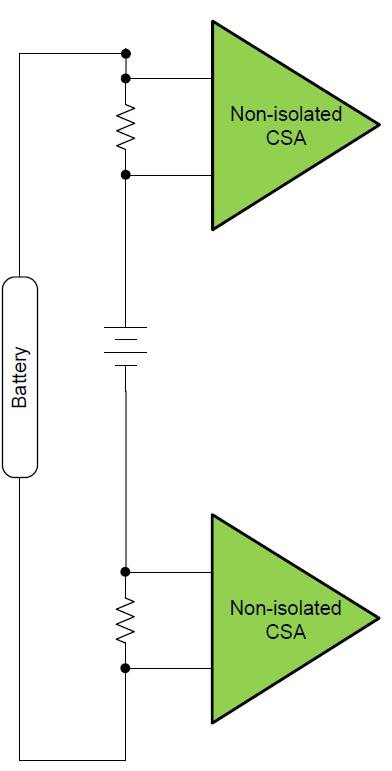SSZT475 may 2019 DRV425 , INA226-Q1
While driving through cities across the world, it’s impossible not to notice the emerging presence of hybrid electric vehicles (HEVs) and electric vehicles (EVs). With the rapid growth of HEVs and EVs in the automotive market, systems such as battery management become significant.
Take, for instance, your cellphone’s battery. You’re constantly checking its status to ensure that you can use your phone throughout the day. Now translating this to a car, imagine how crucial such information becomes.
There are a variety of current sensing technologies that can monitor the status of an HEV or EV battery. The solution varies with the voltage and capacity of the battery. As shown in Figure 1, there are two main locations where you can measure current: top of stack (high-side sensing) and bottom of stack (low-side sensing).
 Figure 1 Top of Stack vs. Bottom of
Stack in a Battery Management System
Figure 1 Top of Stack vs. Bottom of
Stack in a Battery Management SystemTypically, the batteries in electric vehicles are 400 V-800 V. In such a system, isolated current sensing solutions are preferable when performing top-of-stack current measurement.
TI offers multiple options for isolated current sensing. The DRV425 is an integrated magnetic fluxgate sensor integrated circuit that when implemented as a pair can be used for high-precision bus-bar measurement. TI also offers a family of isolated current sense amplifiers that can monitor shunts at the top of high-voltage battery stacks.
Bottom-of-stack current sensing in EV systems and both high- and low-side current sensing in 48-V/12-V HEV systems typically do not require isolated current sensing.
For many years, current sense amplifiers have been implemented in applications used for current and power measurement. These simple and affordable solutions enable designers to achieve real-time overcurrent protection, system optimization and current measurement for closed-loop circuits with excellent linearity and accuracy.
Depending on system requirements and designer preferences, the type of current sense amplifier required will vary. TI offers wide portfolios of current sense amplifiers with common-mode range, offset voltage, gain error and drift options. For HEV/EV battery management systems, the decision between current sense amplifiers with an analog or digital output may be important.
Watch the video series
As shown on the left side of Figure 2, current sense amplifiers with an analog output integrate gain-setting resistors and send an amplified signal to the single-ended analog-to-digital converter (ADC) based on the differential voltage measured across the shunt resistor. For analog output current sense amplifiers, the value of the shunt resistor depends on the full-scale output, maximum input current and gain. The minimum current is limited to the value of the shunt and the offset voltage of the device. The ADC reference will be an additional error source that requires evaluation in the signal path. While current sense amplifiers with analog outputs are still highly accurate and extensively used in battery management systems, current sense amplifiers with a digital output may offer additional value.
TI’s digital output current sense amplifiers (shown on the right in Figure 2) integrate a specialized delta-sigma ADC that eliminates the need to amplify the input signal to maximize the ADC’s full-scale input range across the shunt resistor. Due to the delta-sigma architecture, digital output devices have lower input offset voltages, which enable higher precision measurements at low currents. Thus, you can use a smaller-value shunt resistor for improved system efficiency.
 Figure 2 Analog vs. Digital Output
Current Sense Amplifiers
Figure 2 Analog vs. Digital Output
Current Sense AmplifiersCurrent measurement applications such as battery management systems require the robust performance offered by current sense amplifiers. TI’s portfolio of current sense amplifiers encompasses many needs, from wide common mode range, low offset voltage and small gain error.
Additional Resources
- Dive into TI’s end-equipment reference diagram for battery management systems.
- Learn more about the DRV425 bus-bar implementation
- Check out the “Simplifying Current Sensing” e-book and “Current Sense Amplifiers Guide.”
- Learn more about the INA226-Q1 digital output current sense amplifier in battery management systems